路徑幾何概觀
本主題描述如何使用 Direct2D 路徑幾何來建立複雜的繪圖。 包含以下幾節。
必要條件
本概觀假設您已熟悉建立基本的 Direct2D 應用程式,如 建立簡單的 Direct2D 應用程式中所述。 它也假設您已熟悉 Direct2D 幾何的基本功能,如 幾何概觀中所述。
Direct2D 中的路徑幾何
路徑幾何是由 ID2D1PathGeometry 介面表示。 若要具現化路徑幾何,請呼叫 ID2D1Factory::CreatePathGeometry 方法。 這些物件可用來描述由弧線、曲線和線條等線段組成的複雜幾何圖形。 若要以圖形和區段填入路徑幾何,請呼叫 Open 方法來擷取 ID2D1GeometrySink,並使用 geometry 接收器的方法將圖形和區段新增至路徑幾何。
使用 ID2D1GeometrySink 填入路徑幾何
ID2D1GeometrySink 描述可包含線條、弧形、三次方 Bezier 曲線和二次方 Bezier 曲線的幾何路徑。
幾何接收是由一或多個圖形所組成。 每個圖表是由一或多個線條、曲線或弧線段所組成。 若要建立圖表,請呼叫 BeginFigure 方法,傳入圖形的起點,然後使用其 Add 方法 (,例如 AddLine 和 AddBezier) 來新增區段。 當您完成新增區段時,請呼叫 EndFigure 方法。 您可以重複此順序來建立其他圖表。 當您完成建立圖形時,請呼叫 Close 方法。
範例:建立複雜的繪圖
下圖顯示具有線條、弧線和 Bezier 曲線的複雜繪圖。 下列程式碼範例示範如何使用四個路徑幾何物件來建立繪圖、一個用於左山、一個用於右山、一個用於水流,另一個用於具有耙岩的太陽。
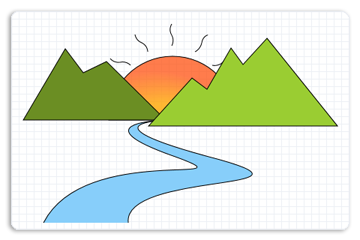
建立左山的路徑幾何
此範例會先建立左山的路徑幾何,如下圖所示。
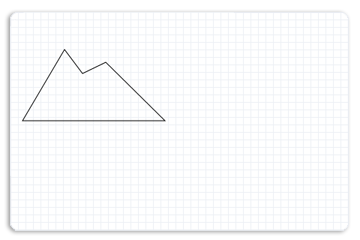
為了建立左山,此範例會呼叫 ID2D1Factory::CreatePathGeometry 方法來建立 ID2D1PathGeometry。
hr = m_pD2DFactory->CreatePathGeometry(&m_pLeftMountainGeometry);
然後,此範例會使用 Open 方法來從 ID2D1PathGeometry 取得幾何接收,並將其儲存在 pSink 變數中。
ID2D1GeometrySink *pSink = NULL;
hr = m_pLeftMountainGeometry->Open(&pSink);
此範例接著會呼叫 BeginFigure,傳入表示此圖已填入 的 D2D1_FIGURE_BEGIN_FILLED , 接著會呼叫 AddLines、傳入 D2D1_POINT_2F 點陣列、 (267、177) 、 (236、192) 、 (212、160) 、 (156、255) 和 (346、255) 。
下列程式碼示範如何執行這項操作。
pSink->SetFillMode(D2D1_FILL_MODE_WINDING);
pSink->BeginFigure(
D2D1::Point2F(346,255),
D2D1_FIGURE_BEGIN_FILLED
);
D2D1_POINT_2F points[5] = {
D2D1::Point2F(267, 177),
D2D1::Point2F(236, 192),
D2D1::Point2F(212, 160),
D2D1::Point2F(156, 255),
D2D1::Point2F(346, 255),
};
pSink->AddLines(points, ARRAYSIZE(points));
pSink->EndFigure(D2D1_FIGURE_END_CLOSED);
建立右山的路徑幾何
然後,此範例會為右山建立另一個路徑幾何,其點 (481、146) (449、181) 、 (433、159) 、 (401、214) 、 (381、199) 、 (323、263) 和 (575、263) 。 下圖顯示右山的顯示方式。
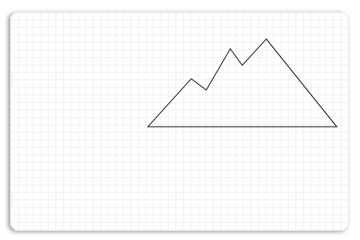
下列程式碼示範如何執行這項操作。
hr = m_pD2DFactory->CreatePathGeometry(&m_pRightMountainGeometry);
if(SUCCEEDED(hr))
{
ID2D1GeometrySink *pSink = NULL;
hr = m_pRightMountainGeometry->Open(&pSink);
if (SUCCEEDED(hr))
{
pSink->SetFillMode(D2D1_FILL_MODE_WINDING);
pSink->BeginFigure(
D2D1::Point2F(575,263),
D2D1_FIGURE_BEGIN_FILLED
);
D2D1_POINT_2F points[] = {
D2D1::Point2F(481, 146),
D2D1::Point2F(449, 181),
D2D1::Point2F(433, 159),
D2D1::Point2F(401, 214),
D2D1::Point2F(381, 199),
D2D1::Point2F(323, 263),
D2D1::Point2F(575, 263)
};
pSink->AddLines(points, ARRAYSIZE(points));
pSink->EndFigure(D2D1_FIGURE_END_CLOSED);
}
hr = pSink->Close();
SafeRelease(&pSink);
}
建立太陽的路徑幾何
然後,此範例會為太陽填入另一個路徑幾何,如下圖所示。
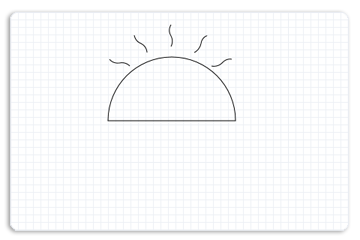
若要這樣做,路徑幾何會建立接收,並將弧形的圖形和每個接收器的圖形新增至接收器。 藉由重複 BeginFigure序列,其 Add (例如 AddBezier) 方法,以及 EndFigure,會將多個圖形新增至接收。
下列程式碼示範如何執行這項操作。
hr = m_pD2DFactory->CreatePathGeometry(&m_pSunGeometry);
if(SUCCEEDED(hr))
{
ID2D1GeometrySink *pSink = NULL;
hr = m_pSunGeometry->Open(&pSink);
if (SUCCEEDED(hr))
{
pSink->SetFillMode(D2D1_FILL_MODE_WINDING);
pSink->BeginFigure(
D2D1::Point2F(270, 255),
D2D1_FIGURE_BEGIN_FILLED
);
pSink->AddArc(
D2D1::ArcSegment(
D2D1::Point2F(440, 255), // end point
D2D1::SizeF(85, 85),
0.0f, // rotation angle
D2D1_SWEEP_DIRECTION_CLOCKWISE,
D2D1_ARC_SIZE_SMALL
));
pSink->EndFigure(D2D1_FIGURE_END_CLOSED);
pSink->BeginFigure(
D2D1::Point2F(299, 182),
D2D1_FIGURE_BEGIN_HOLLOW
);
pSink->AddBezier(
D2D1::BezierSegment(
D2D1::Point2F(299, 182),
D2D1::Point2F(294, 176),
D2D1::Point2F(285, 178)
));
pSink->AddBezier(
D2D1::BezierSegment(
D2D1::Point2F(276, 179),
D2D1::Point2F(272, 173),
D2D1::Point2F(272, 173)
));
pSink->EndFigure(D2D1_FIGURE_END_OPEN);
pSink->BeginFigure(
D2D1::Point2F(354, 156),
D2D1_FIGURE_BEGIN_HOLLOW
);
pSink->AddBezier(
D2D1::BezierSegment(
D2D1::Point2F(354, 156),
D2D1::Point2F(358, 149),
D2D1::Point2F(354, 142)
));
pSink->AddBezier(
D2D1::BezierSegment(
D2D1::Point2F(349, 134),
D2D1::Point2F(354, 127),
D2D1::Point2F(354, 127)
));
pSink->EndFigure(D2D1_FIGURE_END_OPEN);
pSink->BeginFigure(
D2D1::Point2F(322,164),
D2D1_FIGURE_BEGIN_HOLLOW
);
pSink->AddBezier(
D2D1::BezierSegment(
D2D1::Point2F(322, 164),
D2D1::Point2F(322, 156),
D2D1::Point2F(314, 152)
));
pSink->AddBezier(
D2D1::BezierSegment(
D2D1::Point2F(306, 149),
D2D1::Point2F(305, 141),
D2D1::Point2F(305, 141)
));
pSink->EndFigure(D2D1_FIGURE_END_OPEN);
pSink->BeginFigure(
D2D1::Point2F(385, 164),
D2D1_FIGURE_BEGIN_HOLLOW
);
pSink->AddBezier(
D2D1::BezierSegment(
D2D1::Point2F(385,164),
D2D1::Point2F(392,161),
D2D1::Point2F(394,152)
));
pSink->AddBezier(
D2D1::BezierSegment(
D2D1::Point2F(395,144),
D2D1::Point2F(402,141),
D2D1::Point2F(402,142)
));
pSink->EndFigure(D2D1_FIGURE_END_OPEN);
pSink->BeginFigure(
D2D1::Point2F(408,182),
D2D1_FIGURE_BEGIN_HOLLOW
);
pSink->AddBezier(
D2D1::BezierSegment(
D2D1::Point2F(408,182),
D2D1::Point2F(416,184),
D2D1::Point2F(422,178)
));
pSink->AddBezier(
D2D1::BezierSegment(
D2D1::Point2F(428,171),
D2D1::Point2F(435,173),
D2D1::Point2F(435,173)
));
pSink->EndFigure(D2D1_FIGURE_END_OPEN);
}
hr = pSink->Close();
SafeRelease(&pSink);
}
建立 River 的路徑幾何
然後,此範例會為包含 Bezier 曲線的 River 建立另一個幾何路徑。 下圖顯示如何顯示該水流。
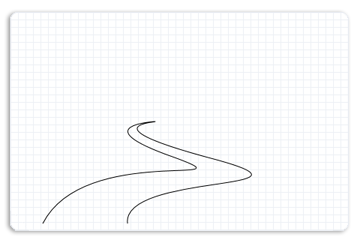
下列程式碼示範如何執行這項操作。
hr = m_pD2DFactory->CreatePathGeometry(&m_pRiverGeometry);
if(SUCCEEDED(hr))
{
ID2D1GeometrySink *pSink = NULL;
hr = m_pRiverGeometry->Open(&pSink);
if (SUCCEEDED(hr))
{
pSink->SetFillMode(D2D1_FILL_MODE_WINDING);
pSink->BeginFigure(
D2D1::Point2F(183, 392),
D2D1_FIGURE_BEGIN_FILLED
);
pSink->AddBezier(
D2D1::BezierSegment(
D2D1::Point2F(238, 284),
D2D1::Point2F(472, 345),
D2D1::Point2F(356, 303)
));
pSink->AddBezier(
D2D1::BezierSegment(
D2D1::Point2F(237, 261),
D2D1::Point2F(333, 256),
D2D1::Point2F(333, 256)
));
pSink->AddBezier(
D2D1::BezierSegment(
D2D1::Point2F(335, 257),
D2D1::Point2F(241, 261),
D2D1::Point2F(411, 306)
));
pSink->AddBezier(
D2D1::BezierSegment(
D2D1::Point2F(574, 350),
D2D1::Point2F(288, 324),
D2D1::Point2F(296, 392)
));
pSink->EndFigure(D2D1_FIGURE_END_OPEN);
}
將路徑幾何轉譯到顯示器
下列程式碼示範如何在顯示器上呈現填入的路徑幾何。 它會先繪製並繪製太陽幾何,接著是左山幾何,接著是水道幾何,最後是右山幾何。
m_pRenderTarget->BeginDraw();
m_pRenderTarget->SetTransform(D2D1::Matrix3x2F::Identity());
m_pRenderTarget->Clear(D2D1::ColorF(D2D1::ColorF::White));
D2D1_SIZE_F rtSize = m_pRenderTarget->GetSize();
m_pRenderTarget->FillRectangle(
D2D1::RectF(0, 0, rtSize.width, rtSize.height),
m_pGridPatternBitmapBrush
);
m_pRenderTarget->FillGeometry(m_pSunGeometry, m_pRadialGradientBrush);
m_pSceneBrush->SetColor(D2D1::ColorF(D2D1::ColorF::Black, 1.f));
m_pRenderTarget->DrawGeometry(m_pSunGeometry, m_pSceneBrush, 1.f);
m_pSceneBrush->SetColor(D2D1::ColorF(D2D1::ColorF::OliveDrab, 1.f));
m_pRenderTarget->FillGeometry(m_pLeftMountainGeometry, m_pSceneBrush);
m_pSceneBrush->SetColor(D2D1::ColorF(D2D1::ColorF::Black, 1.f));
m_pRenderTarget->DrawGeometry(m_pLeftMountainGeometry, m_pSceneBrush, 1.f);
m_pSceneBrush->SetColor(D2D1::ColorF(D2D1::ColorF::LightSkyBlue, 1.f));
m_pRenderTarget->FillGeometry(m_pRiverGeometry, m_pSceneBrush);
m_pSceneBrush->SetColor(D2D1::ColorF(D2D1::ColorF::Black, 1.f));
m_pRenderTarget->DrawGeometry(m_pRiverGeometry, m_pSceneBrush, 1.f);
m_pSceneBrush->SetColor(D2D1::ColorF(D2D1::ColorF::YellowGreen, 1.f));
m_pRenderTarget->FillGeometry(m_pRightMountainGeometry, m_pSceneBrush);
m_pSceneBrush->SetColor(D2D1::ColorF(D2D1::ColorF::Black, 1.f));
m_pRenderTarget->DrawGeometry(m_pRightMountainGeometry, m_pSceneBrush, 1.f);
hr = m_pRenderTarget->EndDraw();
完整的範例會輸出下圖。

相關主題